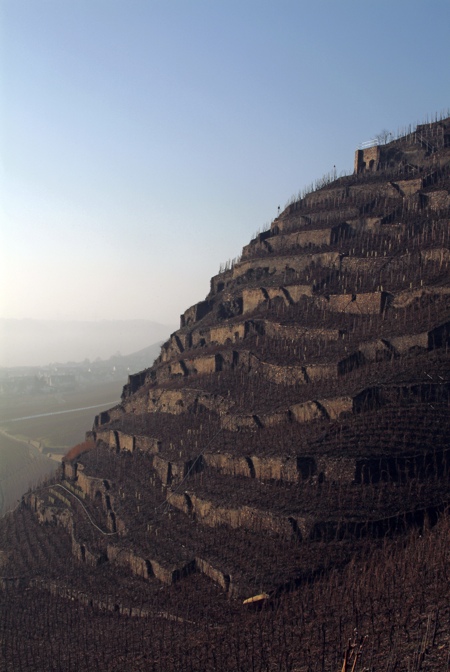- June 8, 2012
A Shot of Röttgen
- by Lars Carlberg
 Winninger Röttgen is one of the great vineyards of the Lower Mosel. It looks like the northern Rhône’s Côte-Rôtie. This beautiful photograph, with the village of Winningen in the background, only shows a part of Röttgen, but captures the vineyard’s magnitude. Heymann-Löwenstein describes the soil as primarily blue slate and oxidizing yellow-brown to blue-black. Knebel’s old-vine parcel in Röttgen, on a mid-slope plateau, is strewn with big chunks of gray-blue slate.
Winninger Röttgen is one of the great vineyards of the Lower Mosel. It looks like the northern Rhône’s Côte-Rôtie. This beautiful photograph, with the village of Winningen in the background, only shows a part of Röttgen, but captures the vineyard’s magnitude. Heymann-Löwenstein describes the soil as primarily blue slate and oxidizing yellow-brown to blue-black. Knebel’s old-vine parcel in Röttgen, on a mid-slope plateau, is strewn with big chunks of gray-blue slate.
Stuart Pigott’s Mosel, from his Weinreisen series (Wine Travel, Scherz, 2009), has the same photo with the clever caption: "Tower of Babel?!" His wine travels to the various German regions are actually from his larger volume Wein spricht deutsch (Wine Speaks German, same publisher, 2007).
In Terrassenkultur an der Untermosel (Terraces of the Lower Mosel, Edition Krieger, 2003), Joachim Krieger writes that Röttgen—on some old maps spelled “Rötchen”—was second only to Uhlen in esteem. Records of Röttgen as a vineyard site, go as far back as 1820. Many of the dry stone terraces in today’s Röttgen were formed from controlled demolitions. It was a method that Carl August Immich made famous in the mid-19th century using explosives to blow up a slate outcrop in Enkircher Zeppwingert to form the Monopollage, or monopole site, called Batterieberg.
The original “Im Rötchen” is actually by the Winninger Röttgen sign further downstream towards Koblenz, where the Mosel flows into the mighty Rhine. According to Beate Knebel, the section of the hillside on the photograph was formerly part of the ur-Im Brückstück that became part of Röttgen in 1912.
Röttgen’s microclimate is among the warmest in the Mosel region, including influence from the nearby Rhine. Its wines tend to be relatively fruity and lively, whereas Uhlen’s can be more salty and austere. In addition, Krieger says that Röttgen is predestined for making noble sweet Rieslings, such as those from Knebel. ♦
Photograph by Andreas Durst.
- Posted in Articles, Vineyards
- | Tagged: Heymann-Löwenstein, Joachim Krieger, Knebel, Stuart Pigott, Winninger Röttgen



Great shot. Thank you.
You’re welcome, Lyle. It’s indeed a great shot by Andreas Durst.